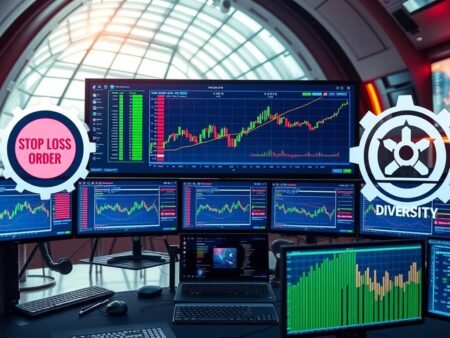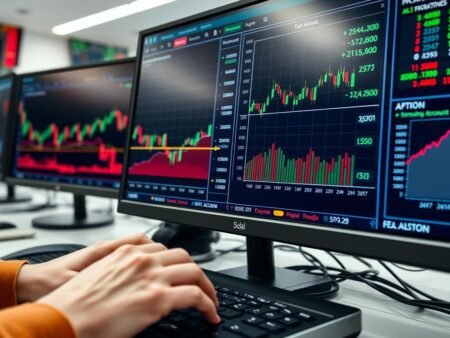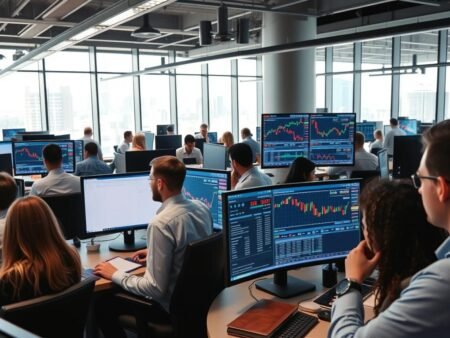In the fast-paced world of proprietary trading, knowing how to handle risks is key to success. Prop trading risk management is crucial for trading firms to thrive. It helps traders avoid big losses and keeps the firm growing.
While traders focus on making trades, trading firm risk mitigation is the backbone of success. It protects against financial risks and supports the firm’s growth. By doing thorough prop trading risk analysis, traders and firms can get ready for market changes.
Let’s dive into the world of risk management in prop firm trading. It’s a journey into the heart of what makes trading firms successful.
Key Takeaways
- Understanding the critical nature of risk management in safeguarding prop trading longevity and success.
- The strategic impact of effective risk mitigation on the viability and competitiveness of trading firms.
- Insights into the methodologies and tools essential for precise risk analysis in prop trading.
- How prop firms incorporate sophisticated risk management strategies into everyday trading decisions.
- Exploring the symbiotic relationship between risk evaluation and fiscal responsibility within a prop trading context.
The Role of Risk Management in Prop Firm Trading
In proprietary trading firms, good risk management is key for both quick wins and long-term success. Traders who excel in risk management techniques and do regular risk assessment in prop trading are very valuable. These firms need strong risk management to protect their big investments and try to make more money.
Risk management is crucial in trading because it deals with both chances and risks. To succeed in proprietary trading, you need to know the markets well and manage risks well. This helps avoid big losses.
Understanding the Importance of Risk Management in Trading
Good risk management keeps traders and firms safe from taking on too much risk. It shapes how traders analyze markets, make decisions, and perform overall. By using risk management techniques, prop traders can avoid big losses. This is key for both the trader’s and the firm’s financial health.
How Risk Management Affects Prop Trading Firms’ Viability
Good risk assessment in prop trading lets firms stay strong through market ups and downs. It helps them keep going and maintain a stable trading place. This assessment makes sure trading plans match market conditions and risk levels. So, checking risks often is a main part of a prop firm’s plan to grow and make more money.
Introduction to Prop Trading Risk Management
In the fast-paced world of proprietary trading, risk control in prop trading is key to protecting and growing a firm’s assets. This introduction to prop trading risk management covers the rules and strategies needed for successful trading.
Good risk management in proprietary trading depends on knowing and using prop trading compliance requirements in all parts of the business. These rules are not just suggestions but are essential for managing and reducing financial risks.
- Identifying possible market risks
- Keeping an eye on trading activities
- Putting in place strong control measures
Following compliance rules and strengthening risk control in prop trading meets regulatory needs. It also builds a culture of careful trading among firm members.
Regulatory compliance is the foundation of effective risk management. It ensures a firm’s long-term success in the unpredictable trading world.
The relationship between prop trading compliance requirements and risk management strategies is complex but vital. It helps prop trading firms not just survive but thrive in tough markets.
As we explore risk management in prop trading further, it’s clear that a proactive approach is crucial. It must be backed by a deep understanding of compliance. This is essential for any firm wanting to be a leader in finance.
Essential Risk Management Techniques for Prop Traders
Prop traders must use effective risk management to protect their investments and increase returns. This section covers key strategies every trader needs.
Managing Leverage and Exposure
Managing leverage and exposure is crucial in prop trading. It helps prevent big losses in volatile markets. Traders can set limits on leverage and adjust them based on market conditions.
This approach keeps capital safe and follows smart trading strategies.
Applying Stop-Loss and Take-Profit Strategies
Stop-loss orders and take-profit points are key in prop trading. They help lock in profits and limit losses. These tools set exit points at specific prices, reducing emotional trading.
They make trading more consistent and disciplined.
Portfolio Diversification as a Risk Management Tool
Diversification is vital for managing risk. It spreads investments across different financial instruments. This way, losses in one area are less likely to affect the whole portfolio.
Diversification works well with prop trading strategies. It helps grow the portfolio while reducing risk.
Prop traders with these risk management techniques can handle market complexities better. This leads to more stable and profitable trading.
Prop Trading Strategies and Risk Mitigation
In the fast-paced world of proprietary trading, it’s crucial to know and use prop trading strategies and risk management techniques well. This part talks about important strategies and how to control risks. It helps traders keep their portfolios balanced and earn steady profits.
Scalping and its Risk Factors
Scalping means making lots of trades quickly, trying to make money from small price changes. It can be profitable but is risky because of the fast pace and small room for mistakes. To manage risks, scalpers use tight stop-loss orders and a solid trading plan to handle sudden market changes.
Long-Term Swing Trading Risks
Swing trading is slower, waiting for the best times to buy and sell over weeks or months. Its main risk is the unpredictable market over time. To deal with this, traders do deep market analysis and use stop losses to keep their money safe when trends change suddenly.
Algorithmic Trading Safety Measures
Algorithmic trading uses complex algorithms to make trades automatically. It can make trading faster but also brings risks like system failures and wrong data interpretation. Important safety steps include testing algorithms well and limiting trade sizes and total exposure.
| Strategy | Risk Management Technique | Benefit |
|---|---|---|
| Scalping | Tight stop-loss orders | Minimizes losses on individual trades |
| Long-term Swing Trading | Use of protective stops | Protects against market reversals |
| Algorithmic Trading | Backtesting algorithms thoroughly | Ensures the reliability of trading processes |
Best Practices in Risk Assessment for Prop Trading
Effective risk assessment in prop trading is key for staying ahead and keeping a trading firm stable. This part looks at top practices to boost trading firm risk mitigation strategies.
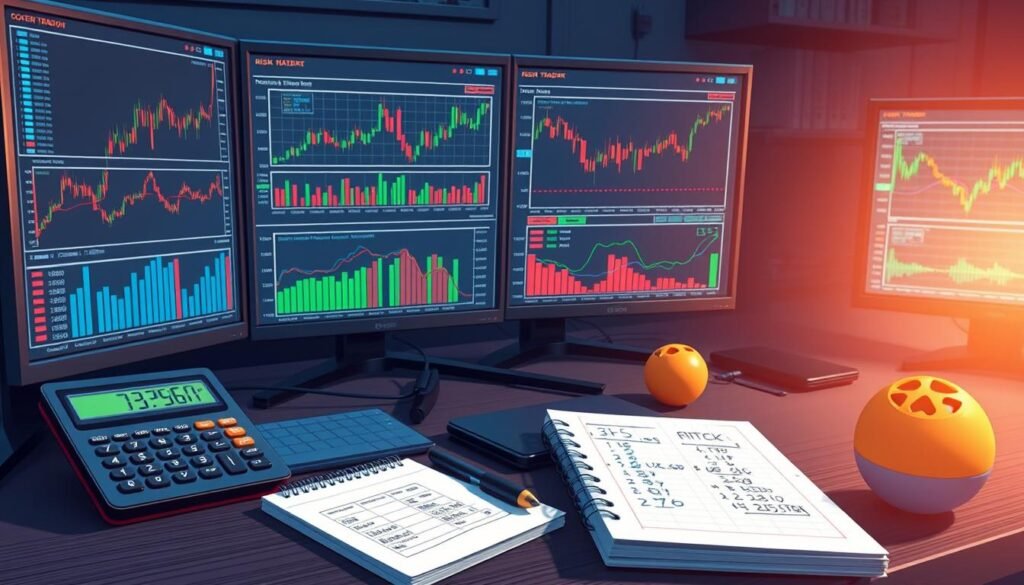
Using both qualitative and quantitative methods is important. Qualitative methods give insight into market behaviors and trader psychology. Quantitative data offers numbers and trends to support these insights.
- Regular Review of Risk Policies: Firms must update their risk assessment methods to keep up with market changes.
- Transparency with Stakeholders: Keeping stakeholders in the loop about risk management builds trust and helps in making better decisions.
- Stress Testing: Testing strategies in hypothetical worst-case scenarios shows how they perform under extreme conditions.
Creating risk metrics that fit a firm’s specific strategies and goals is also key. This makes the assessment relevant and dynamic.
| Strategy Type | Risk Assessment Technique | Benefit |
|---|---|---|
| Scalping | Real-time volatility assessment | Minimizes losses due to rapid price changes |
| Swing Trading | Historical data analysis | Identifies patterns for better entry and exit points |
| Algorithmic Trading | Algorithm robustness testing | Ensures strategy performs under varied market conditions |
By taking a comprehensive approach to risk assessment in prop trading, trading activities become safer and more profitable. This builds a solid base for trading firm risk mitigation.
Risk Management Frameworks Used by Top Prop Trading Firms
In today’s fast-changing financial world, prop trading strategies and risk management techniques are key. They help top trading firms succeed. This section looks at the frameworks these firms use to handle market ups and downs and changes in rules.
Identifying a Robust Risk Management Framework
Creating a strong risk management framework needs a deep understanding of the market and the firm’s trading habits. Top firms spend a lot on research and data analysis. They look for patterns to set their risk limits.
They consider things like market volatility, how often they trade, and how much money they use. This helps them build solid risk management plans that support their trading strategies.
Customization of Risk Frameworks to Match Trading Style
Customizing risk management is crucial in proprietary trading. Each firm has its own way of trading and how much risk it’s willing to take. They need risk management plans that fit their prop trading strategies.
This way, they can better handle market changes. It helps them avoid big losses and make the most of their gains.
For example, a firm that trades a lot might use tools that watch risks in real-time and set off alarms quickly. A firm that holds trades for a long time might look at big economic trends and plan when to sell.
So, making these plans fit the firm’s style is very important. It makes the trading environment more responsive and flexible.
Also, keeping risk models and methods up to date is key. It helps firms stay ahead and follow rules in a world that’s always changing.
In short, top proprietary trading firms keep improving their risk management plans. They do this to keep up with market trends and their own trading strategies. This helps them stay strong and profitable in a tough market.
Critical Risk Management Roles within Prop Trading Firms
In prop trading, managing risks is key to keeping the firm stable and financially healthy. This part explains the main roles in the firm that keep these standards high.
The Function of a Risk Manager in a Prop Firm
A risk manager is vital in creating and carrying out risk management plans for prop trading. They spot, study, and lessen risks that could hurt the firm. They make sure all trading follows risk rules by setting limits and checking if traders stick to them.
The Trader’s Responsibility in Managing Risk
Traders also have a big part in managing risks. They must follow the risk rules set by the firm. This means they should keep their trades within limits and tell the firm about any risks that might break these rules.
| Role | Responsibilities | Impact on Risk Control |
|---|---|---|
| Risk Manager | Analyzing risk sources, supervising risk management protocols, setting risk limits. | Central to defining and executing the risk management operations; ensures adherence to risk limits. |
| Trader | Engaging in trading within defined risk parameters, immediate reporting of non-compliance. | Directly affects the firm’s risk profile with trade actions; responsible for maintaining risk awareness. |
Regulatory and Compliance Requirements in Prop Trading
In the world of prop trading, following strict prop trading compliance requirements is key. It protects firms from legal trouble and keeps the market fair. This part looks at how rules shape prop trading risk analysis and how it’s done.
Global regulators have set clear rules for prop trading firms. They must have enough money, follow reporting rules, and manage risks well. These rules help reduce big risks and keep markets open and honest.
- Capital Adequacy Requirements: Ensuring that firms have enough capital to withstand trading losses without jeopardizing their solvency.
- Reporting Obligations: Mandatory submission of trade and transaction reports, aiding in oversight and surveillance.
- Risk Management Protocols: Instituting necessary checks and balances to mitigate trading risks.
When rules change, firms must quickly adjust their plans and actions. Good prop trading risk analysis helps them get ready for these changes.
With evolving markets, compliance is not just a legal checkpoint, but a dynamic layer of risk management that prop trading firms must continuously improve upon to safeguard their interests and those of the broader financial ecosystem.
Knowing and using these rules well helps firms pass checks and stay ahead. They can manage risks better, which is key to success.
Case Studies: How Risk Management Saved Prop Firms
In the world of proprietary trading, managing risk is key. This section looks at times when good risk management saved and even improved trading firms.
Evaluating Successful Risk Management Scenarios
Many prop trading firms have used smart risk management to boost their success. They’ve used advanced tools to predict market changes and adjust their plans quickly. This has helped them keep their profits steady, even when markets are tough.
These firms also use top-notch analytics to watch their risk on each trade. This careful monitoring has helped them stay profitable, even in unpredictable times.
Analyzing Failures: Lessons from Mismanaged Risks
On the other hand, some firms didn’t focus enough on risk control. They didn’t set clear loss limits or understand their leverage well. Without good risk management, small market shifts could cause big losses. This led to financial trouble and even the collapse of some firms.
These stories show how important strong risk management is for prop trading firms. Each example teaches us the importance of always checking and updating our risk strategies. This helps protect our assets and keeps us competitive in the fast-paced world of prop trading.
Implementing a Culture of Risk Control in Prop Trading
Prop trading firms now focus more on the balance between risk and return. They need a culture that controls risk well. This culture is not just about keeping up with the market. It’s about being ready for the future with confidence.
This culture affects every part of the business. It shapes who they hire, how they train, and how they trade. It mixes prop trading strategies with ways to reduce risk.
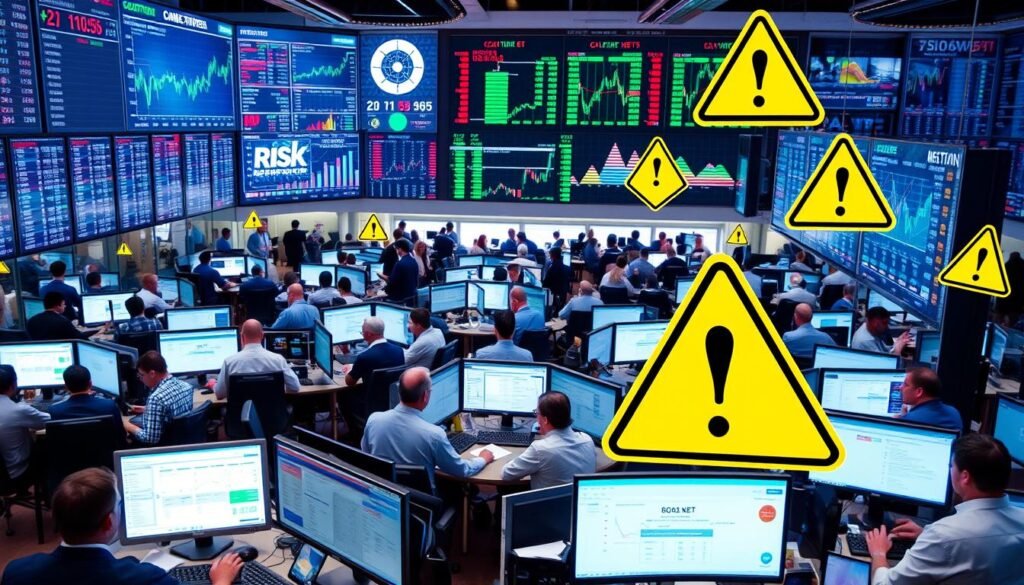
To start a culture focused on risk, firms need to choose the right people. They should look for those who know about risk and care about it. This team can then spread these values throughout the company.
Having risk control as a core value is key. It guides every decision and plan the firm makes.
- Training programs focus on improving trading skills and understanding risks.
- Regular checks and feedback help spot and fix risk issues in strategies and decisions.
- Strategic meetings make sure everyone knows and supports the firm’s risk goals.
Creating a strong risk control culture takes effort and dedication. It shows in how risk is part of daily work and planning. Here’s how top prop trading firms handle risk:
| Aspect | Description | Impact on Risk Control |
|---|---|---|
| Recruitment | Hiring with a focus on risk sensitivity | Builds a foundation of risk-aware professionals |
| Training | Ongoing risk management education | Keeps team updated on latest risk control techniques |
| Strategic Alignment | Risk control integrated into business strategies | Ensures consistent application of risk measures |
Having a risk-focused culture in prop trading firms makes trading safer and more stable. It helps the firm grow and stay strong in a changing market. By focusing on risk control, firms can stay ahead and succeed, even when things get tough.
Risk Control: Using Technology to Enhance Prop Trading Safety
In today’s world, managing risks in prop trading is crucial for firms to stay competitive. Advanced technology is key for controlling risks. This section looks at how new tools help protect trading strategies from unexpected losses.
Automation in Risk Monitoring and Management
Automation is changing how prop trading firms manage risks. With automated systems, firms can watch lots of trading data live. This lets them quickly respond to market changes.
Automation makes risk assessments more accurate. It also cuts down the time needed to act on risks.
Technological Solutions for Real-Time Risk Analysis
Prop trading firms use tech to analyze data fast. These tools help them keep an eye on the market and warn of risks quickly. They use predictive analytics to guess when markets might change.
This helps traders adjust their plans fast. It’s a big help in managing risks.
| Technology | Function | Impact on Risk Management |
|---|---|---|
| Automated Trading Systems | Execute trades at optimal prices without manual intervention | Minimizes slippage, maintains consistency, and reduces emotional trading risks |
| Predictive Analytics Software | Analyzes past and present data to predict future market behaviors | Enhances decision-making by anticipating market movements and potential risks |
| Real-time Risk Management Dashboards | Provide live visual feedback on key performance and risk metrics | Allows for immediate adjustments to strategies, mitigating potential losses effectively |
Using these advanced tools in risk management is vital. As trading gets more complex, firms will rely more on these innovations. This will make trading safer and more effective.
Creating a Risk Management Plan for Prop Traders
Creating a solid risk management plan is key for keeping profits up and risks down in proprietary trading. By using smart trading firm risk strategies and prop trading risk management, traders can better handle market ups and downs.
Key Components of a Successful Risk Plan
A good risk management plan for prop traders has a few key parts. These parts help protect against unexpected market changes. They include setting clear risk goals, finding specific risk limits, and making rules for trading. It’s also important to keep checking and changing strategies to match the market.
Stress Testing and Scenario Analysis in Planning
Stress testing and scenario analysis are very important in prop trading risk management. They help traders see how different market conditions might affect their trading. This way, traders can plan for possible losses and adjust their risk levels, staying ready for any market situation.
| Component | Description | Benefit |
|---|---|---|
| Goal Setting | Defining clear and quantifiable objectives for risk tolerance and target returns. | Provides a benchmark for measuring the risk-adjusted performance of trades. |
| Risk Assessment | Evaluating the potential risks associated with different trading strategies and asset classes. | Helps in understanding diverse risk factors and managing allocation effectively. |
| Scenario Analysis | Examining the effects of hypothetical market scenarios on trading outcomes. | Prepares traders for extreme market events, reducing potential shocks and losses. |
| Strategy Adaptation | Continuous revision and enhancement of trading strategies based on market feedback. | Ensures ongoing refinement of practices, aligning them more closely with market realities. |
Quantitative vs Qualitative Risk Analysis in Prop Trading
In the world of proprietary trading, managing risk is key. Knowing the difference between quantitative and qualitative risk analysis helps firms make better decisions. Each method has its own strengths and weaknesses.
Quantitative prop trading risk analysis uses math and stats. It looks at market risks and predicts outcomes with past data. This method is great for making quick decisions with solid data.
Qualitative risk assessment in prop trading deals with things that can’t be easily measured. This includes market mood, trader feelings, and global events. It adds depth to the numbers, showing risks that numbers alone can’t catch.
| Quantitative Analysis | Qualitative Analysis |
|---|---|
| Employs statistical models | Utilizes expert judgment |
| Focuses on numerical data | Considers market sentiment |
| Suitable for risk quantification | Explains the ‘why’ behind risks |
| Highly structured approach | Flexible, adaptive approach |
Using both methods gives a full view of the trading world. The power of prop trading risk analysis comes from combining these ways. This mix gives a clearer view of risks and chances in the market.
A top prop trading firm uses both methods for a strong risk framework. This mix improves the accuracy and flexibility of risk assessment in prop trading. It makes firms more adaptable and strategic.
Training and Education in Risk Management for Prop Traders
In the fast-paced world of prop trading, staying updated on prop trading risk management is key. Traders need to know both basic and advanced strategies. This knowledge helps them handle the complex markets well.
Essential Risk Management Skills for Modern Traders
Today’s prop trading world demands more than just trading skills. Traders must be good at managing risks. They need to think critically, make fast decisions with data, and use tools to reduce risks. Training programs are vital for these skills.
Workshops and Simulations for Risk Awareness
Workshops and simulations are essential for learning risk management in prop trading. They let traders practice in a safe space. This way, they see how their choices affect their trading.
Table: Impact of Workshops and Simulations on Risk Management Proficiency
| Workshop/Simulation Type | Skills Developed | Impact on Risk Management |
|---|---|---|
| Real-time Trading Scenarios | Decision-making under pressure, Speed in response | High |
| Risk Analysis Techniques | Risk identification and quantification | Medium |
| Software Tools Training | Use of analytical tools | Medium |
| Comprehensive Review Sessions | Strategic thinking and application | High |
This method improves understanding of prop trading risk management. It also boosts traders’ confidence. This confidence helps them make smart moves in different market situations. It makes their trading more stable and profitable.
Integrating Risk Management with Prop Trading Performance Metrics
In the world of proprietary trading, success used to mean just making profits. But now, trading firm risk mitigation strategies are changing the game. They focus on combining risk management with prop trading performance metrics. This new way of measuring success looks at both profits and risks.
Today, prop trading success is about finding the right balance. A trader might look good on paper but take too many risks. This could put the firm’s money and stability at risk. Smart firms now use metrics that include risk in their evaluations. This helps align a trader’s goals with the firm’s risk level.
For more on this, check out prop trading firms news. It dives into the latest in risk management and its impact on trading. By focusing on risk-aware performance, firms protect themselves and create a better trading environment. This approach values long-term success over quick wins.
